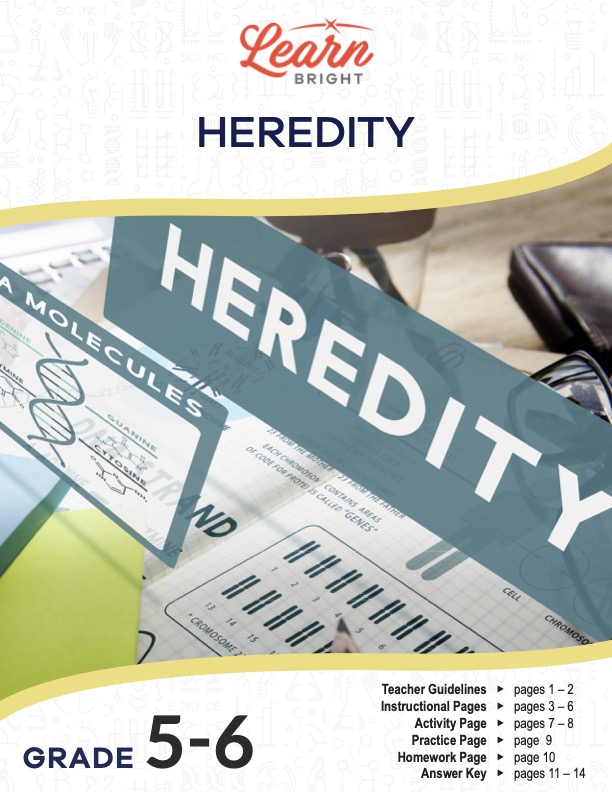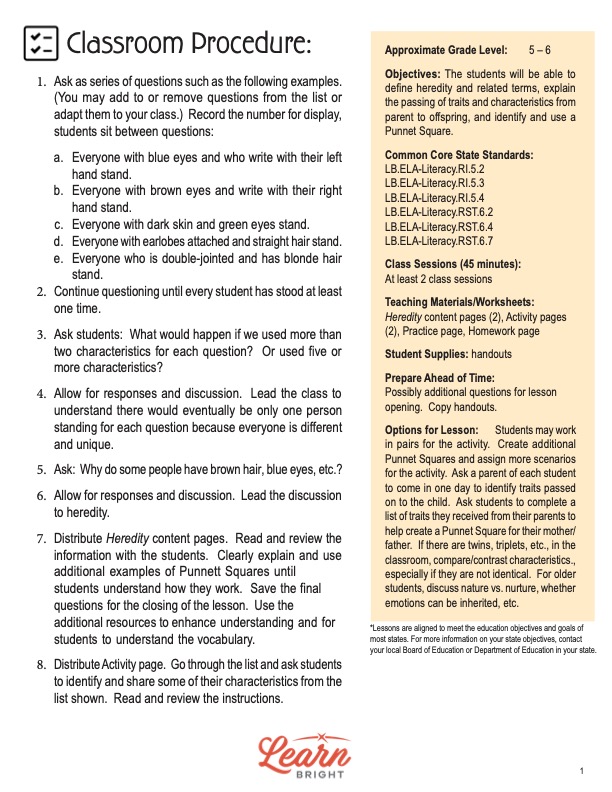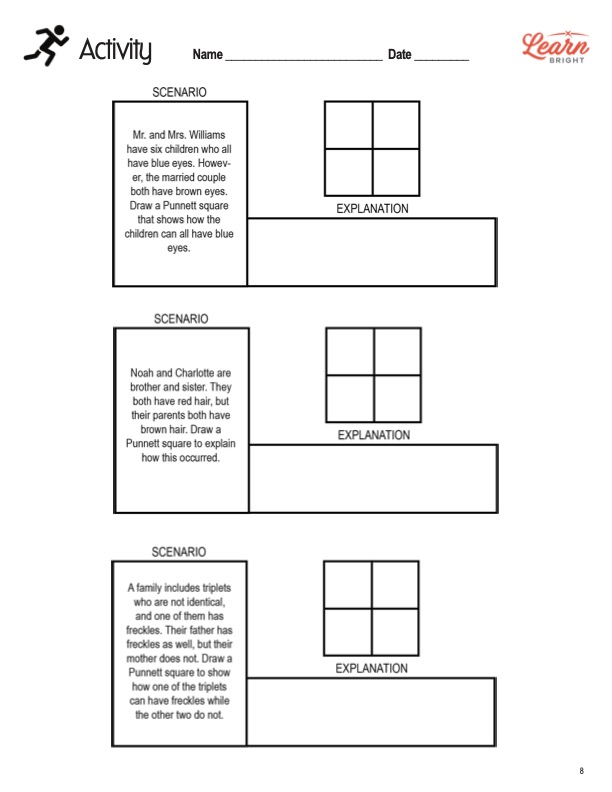Description
What our Heredity lesson plan includes
Lesson Objectives and Overview: Heredity teaches students about the concept of passing traits from one generation to the next. Students will learn how to use Punnett squares to predict the likelihood of inheriting certain traits from their parents. They will also discover how the same concept applies to other animals and plants. This lesson is for students in 5th grade and 6th grade.
Classroom Procedure
Every lesson plan provides you with a classroom procedure page that outlines a step-by-step guide to follow. You do not have to follow the guide exactly. The guide helps you organize the lesson and details when to hand out worksheets. It also lists information in the yellow box that you might find useful. You will find the lesson objectives, state standards, and number of class sessions the lesson should take to complete in this area. In addition, it describes the supplies you will need as well as what and how you need to prepare beforehand.
Options for Lesson
In the “Options for Lesson” section of the classroom procedure page, you will find several suggestions for additional ideas or activities to add to the lesson. For the activity, students could work in pairs, and you could add additional scenarios for them to complete. Another option is to invite a parent of each student to come in one day to identify traits that they passed on to their child. You could also ask students to complete a list of traits they received from their parents to help create Punnett squares for their parents. If you have any twins/triplets/etc. in the class, you could have the students compare and contrast their characteristics. For older students, one more idea is to discuss the concept of nature versus nurture, whether people can inherit emotions, and so on.
Teacher Notes
The teacher notes page provides an extra paragraph of information to help guide the lesson and remind you what to focus on. It suggests using additional resources to complement the lesson, such as a video about heredity. For more advanced students, you may also benefit from a further discussion about nature versus nurture. The blank lines on this page are available for you to write out thoughts and ideas you have as you prepare the lesson.
HEREDITY LESSON PLAN CONTENT PAGES
Genes and DNA
The Heredity lesson plan contains three pages of content. The lesson first explains the concept of heredity as the process of passing on specific traits from one generation to the next, from parent to offspring. Students can consider whether their eyes are the same color as one of their parents if their parents have different colored eyes. Every living thing gets certain traits and characteristics from their parents.
Students will learn that the study of heredity is called genetics. The genes we have determine the traits or characteristics we exhibit, such as hair color, eye color, artistic or athletic ability, height, and more. Every living organism receives its characteristics from its parents. In plants, these traits can include seed color, flower position, length of stem, and much more.
The first person to discover the concept of heredity was Gregor Mendel. He is considered the father of the science of genetics. He studied pea plants and discovered that certain traits passed on from the parent to the offspring. In other words, the offspring inherited those traits from either the female or male plant.
Our traits pass on by genes in our DNA. A gene gives instructions about how to make a certain protein to determine a trait. These genes are located inside a DNA molecule, which is a material in chromosomes. Chromosomes exist in the nucleus of every cell of the body of every living organism. DNA is essentially the recipe for who we are, and the genes are the ingredients. However, we don’t always use all the “ingredients” in the recipe. A person can have brown hair but have a gene for blond hair.
Dominant and Recessive
The concept can be confusing, but students should remember that they have two parents. Humans have 23 pairs of chromosomes in each cell for a total of 46. Each child or offspring receives half of their chromosomes from the mother and half from their father. Therefore, every child inherits half their DNA from each parent. As a result, they can have a different hair color gene from their mother than they do from their father.
However, their hair can only be one color. The hair color the child manifests is determined by the alleles. An allele is the specific pattern inside a gene that determines which trait someone will have. Because we receive two genes for each trait, some of them are more dominant that others. Dominant genes win out over the other. The gene that “loses” is called a recessive gene.
In the case of eye color, for instance, a brown-eye gene is dominant over all other colors, such as blue. This means that if a person inherits genes for brown and blue eyes, they will manifest brown eyes. If, however, they inherit two blue-eye genes, only then will they have blue eyes. The same concept applies to hair color and all other traits. Occasionally, genes can have co-dominance, meaning that neither gene is dominant over the other. An example of this is blood type. If one parent has type A and the other has type B, the child will have a type AB blood.
Even if a trait doesn’t show up in an individual, it can still pass to the next generation. A person might have brown eyes but carries a recessive gene for blue eyes. That person could marry someone with the same gene combination. They could have a child with blue eyes if the genes the child receives from their parents are both for blue eyes.
Heredity and Punnett Squares
In order to figure out the possibility of a child having blue eyes despite having parents with brown eyes, we use Punnett squares. Punnett squares predict the possible combinations and probability of genes passing from parents to offspring. The lesson provides a diagram that details another example with eye color..
The gene for brown eyes is dominant (B) and is recessive for blue eyes (b). One parent has blue eyes and thus has a bb combination. The other has brown eyes but a gene for blue eyes, so their combination is Bb. The square highlights the combinations that would yield brown eyes and those that would yield blue. In this case, an offspring has a 50-50 chance of brown or blue eyes.
On the next page, the lesson provides another example using the plant model that Mendel used. The two flowers he used both had a dominant purple gene (P) and recessive white gene (w). Even though both parents had purple flowers, there was still a 25% chance an offspring would have white flowers instead.
Students will learn that sometimes mutations can occur in a DNA sequence in a chromosome. Such mutations can occur due to the effects of smoking, drug or alcohol abuse, or the environment. The cell itself might also have problems. The results of these factors can cause damage to the body and later pass on to a child. Some mutations can cause diseases to become predominant in families.
HEREDITY LESSON PLAN WORKSHEETS
The Heredity lesson plan includes three worksheets: an activity worksheet, a practice worksheet, and a homework assignment. Each one will help students solidify their grasp of the material they learned throughout the lesson. You can refer to the classroom procedure guidelines to know when to hand out each worksheet.
PUNNETT SQUARES ACTIVITY WORKSHEET
Students will complete Punnett squares for a series of scenarios. The worksheet provides a chart that students can use if they need help. Students should use capital letters for dominant traits and lowercase letters for recessive traits. For each scenario, students must write an explanation about the offspring of the parents.
HEREDITY PRACTICE WORKSHEET
The practice worksheet requires students to match definitions with the correct terms. There are 20 total definitions, and students will use the terms in the word bank on the right of the worksheet. You can decide whether or not you allow students to use the content pages for help to complete the assignment.
PUNNETT SQUARES HOMEWORK WORKSHEET
For the homework assignment, students will demonstrate their understanding of Punnett squares. First, they will complete Punnett squares for six traits. Then they must answer nine questions that relate to the completed squares. The last prompt asks them to list which traits are recessive and which are dominant.
Worksheet Answer Keys
The final pages of the lesson plan document are answer keys for the three worksheets. All the answers are in red to make it easy to compare students’ responses to the correct answers. Students responses will vary on the activity worksheet. If you choose to administer the lesson pages to your students via PDF, you will need to save a new file that omits these pages. Otherwise, you can simply print out the applicable pages and keep these as reference for yourself when grading assignments.










